
Understanding the effects of long-term cropping on organic carbon in soils
The challenge
Earth’s soils are second only to the oceans in their capacity to store carbon. However, human-driven agricultural cropping of land has led to a reduction in soil organic carbon (SOC) stocks by around 20-60% worldwide, with much of this carbon released into the atmosphere and contributing to global greenhouse gas emissions. Whilst protecting and re-building SOC within agricultural zones is essential towards efforts to mitigate climate change, the key factors governing the persistence of SOC remain unclear, hindering the development effective land management strategies.
The solution
Researchers from the University of Queensland and the University of Adelaide recently used the Soft X-ray Spectroscopy beamline to investigate SOC chemistry in soils obtained from Southern Queensland. The study compared samples from original native forest, long term cropped lands and cropped lands converted to pasture or plantation. The overall aim was to understand whether SOC lost due to cropping was able to be restored by remediation of the land back to pasture or plantation.
At the beamline, soft X-ray absorption spectroscopy (NEXAFS) was used to identify the carbon species and their relative abundance in the soil, which allowed the researchers to directly compare the effect of long-term cropping on SOC chemistry. The researchers used the beamline’s high throughput automated NEXAFS instrumentation to measure a large number of soil samples from each site, resulting in a comprehensive and statistically robust data set for further analysis.

The impact
It was found that although remediation of long term cropped soil resulted in an increase in carbon content, it was not completely restored to the ideal values that were observed in soils from remnant vegetation. Interestingly, it was found that cropping strongly reduced the particulate organic matter fraction, whilst the carbon associated with soil minerals (e.g clays) was more robust.
The results of the study helped to advance understanding of SOC dynamics and behaviour for this region of Queensland, and in general contributes toward our understanding of how to optimize efforts toward preserving SOC in future agricultural practices.
This case study, written by Dr Anton Tadich, was the winner of ANSTO Australian Synchrotron's Case Study Competition Round 2 2025.
Reference:
Hondroudakis, L., Kopittke, P. M., Dalal, R. C., Barnard, M., and Weng, Z. H.: The influence of land use and management on the behaviour and persistence of soil organic carbon in a subtropical Ferralsol, SOIL, 10, 451–465, https://doi.org/10.5194/soil-10-451-2024, 2024.